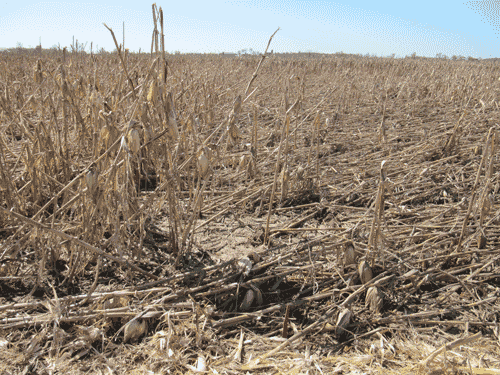Spring corn harvest theory tough in practice
RESEARCH SUGGESTS RISK NOT NECESSARILY WORTH REWARD
for some farmers seeking ways to cut costs, harvesting grain corn in the spring may seem crazy enough that it just might work. But researchers at the University of Guelph say that with today’s markets, in many cases, this theory may just be crazy.
The appeal of potentially reducing their drying cost to zero has enticed more than one farmer into leaving a field of corn out for the winter. Dave Hooker, a Field Crop Agronomist at the University of Guelph’s Ridgetown Campus, had heard anecdotal reports of less than five bushels per acre in yield losses. After calculating a potential $100 per acre increase in net return through reduced drying costs, Hooker and his Ontario Ministry of Agriculture, Food and Rural Affairs colleague, Greg Stewart set out to test this potential money-saver in a two year study.
PHOTO 1: ONE FIELD THAT EXPERIENCED PARTICULARLY BAD LODGING

“Some growers are highly successful with spring harvest,” says Hooker. “But very little research had been done across North America on managing corn with intentions to harvest in the spring.”
Unfortunately, after three of five site years resulting in significantly lower profits for spring harvest compared to harvesting in the fall, Hooker has been forced to conclude spring harvest is not the cost saving solution he’d hoped for. With a final plant stand of 24,000 plants per acre proving to be better than 32,000 plants per acre for improved standability, Hooker says the reduced yield potential at 24,000 is a significant cost to the spring harvest strategy.
Lodging still proved a considerable factor despite all of the management strategies undertaken to increase standability over the winter. Even at the Ridgetown site in both 2009 and 2010 crop years where standability was the highest in the spring, most growers would argue that the amount of lodging found was unacceptable says Hooker.
“Even when using the latest genetics for excellent stalks, full maturities, lower populations, foliar fungicides and early planting, weather during the winter months can overwhelm any combination of management strategies,” says Hooker.
The results of this study did identify some important considerations that may lead to a more favourable case for spring harvesting in the future. It showed the use of a foliar fungicide (QUILT was used in this study) provided a return on investment which more than tripled in most location-years if the corn was overwintered for spring harvest. Longer-than-full season hybrids yielded consistently more than full season hybrids in this study, though grain moisture averaged between one and five percent higher in the fall, which benefited spring harvest. Hooker says he hopes to follow this project up with a study of the quality and presence of mycotoxins in spring harvested grain compared to fall harvest.
on-farm success
Steve Fonger, an experienced spring corn harvester from Kerwood is mostly optimistic about the potential of spring harvesting. Fonger has been choosing to leave corn out for the winter periodically since 1992 on his farm just west of Strathroy. He usually harvests these acres in January, February or March to avoid interfering with spring planting and always pushes the limit on corn heat units by at least 100 CHUs. Even with all the learning experiences it has come with, Fonger says that he’s mostly been happy with his spring harvest results.
“Most of the time, the economics [of spring harvesting] are huge,” said Fonger. “There’s no need for storage, often you can load right into the truck, and the quality is always better.”
But with all of his positive experience, Fonger says spring harvesting is much easier to do when corn is only $3 per bushel and he won’t be planning to harvest a single kernel on his farm this upcoming spring. After one of his worst harvest experiences ever this past spring, due to exceptional weather and the high price of corn, Fonger says he’d hate to see $10,000 just sit in the field again.
“There are very few people who can watch a field stand,” said Fonger. “Spring harvesting is not for everyone.”
taking precautions
For farmers who do decide to attempt a spring harvest in the future, Hooker says there are several factors that must be taken into consideration. It is important to select a hybrid that is full-season with excellent stalk strength, root structure and resistance to corn borer. It will also help to plant early in the season to produce shorter plants that are more resilient in winter weather. Excellent weed control is also imperative and the use of a foliar fungicide at tasseling can provide an additional advantage in improved stalk strength and stability over winter. Hooker says farmers who are operating in areas that are outside of the southwestern snow belt will have the greatest opportunity for success with spring harvesting.
“The risk of spring harvest is high for most corn growers in Ontario, especially with the high value of corn,” said Hooker. “In years of low value corn, when grain moistures exceed 35 percent in the fall and soil conditions are too wet, spring harvest may be more feasible.” •







